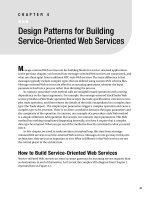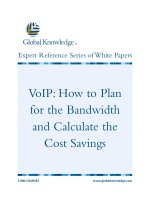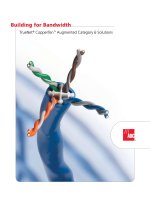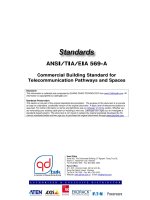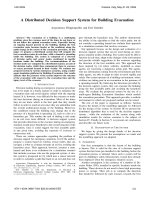Building for Bandwidth
Bạn đang xem bản rút gọn của tài liệu. Xem và tải ngay bản đầy đủ của tài liệu tại đây (802.47 KB, 12 trang )
TrueNet
®
CopperTen
™
Augmented Category 6 Solutions
Building for Bandwidth
THE GIGABIT THRESHOLD WILL FALL
Not long ago, 100 Mbps seemed like enough.
Then Gigabit seemed like enough. Today, when
it comes to planning a cabling infrastructure,
10Gbps has emerged as the next step for satiating
enterprise network bandwidth requirements.
There always has been—and always will be—
a need for more bandwidth. Data-intensive
applications such as network storage and sharing
of imaging and engineering documents alone can
stretch the limits of a cabling system.
Yet what promises to incite bandwidth growth
on a broader scale is the explosion of IP-based
applications: VoIP, WiFi, industrial Ethernet, IPTV,
video conferencing, security cameras, HVAC and
lighting controls, RFID, access controls, badge
readers, and many others on the shelf and in
the lab. This cumulative effect of more IP-based
applications is propelling more data over the
structured cabling system—and demanding more
bandwidth to support these applications.
Historically, a LAN cabling system endures multiple
replacements of switches, routers, PCs, and
other active electronics. On average, the cabling
system remains intact through three generations
of networking gear. With a life cycle of 15 or
more years, the LAN cabling system installed
today is expected to support the next networking
protocol. This was the case with Category 5e and
Category 6. This will be true with 10Gbps cabling
systems, too.
With Augmented Category 6 standards to be
adopted in 2006, Gigabit is no longer the plan-
ning target for building the 15-year structured
cabling system.
Static Web Pages
Interactive Web
Integrated Messaging
CRM
ERP
Voice Over IP
Streaming Video
Video Downloading
High Performance
Computing
Storage WANs
Video Conferencing
Telepresence
Richness of Applications
10 Gbps
1 Gbps
100 Mbps
10 Mbps
Bandwidth Required
IP Factory
Intelligent Buildings
RFID
more
adj. in greater quantity, amount, measure, degree, or number
New emerging
applications will drive
networks past 1 gigabit.
CopperTen
™
Augmented Category 6 Solutions
PIONEERING AUGMENTED CATEGORY 6
The IEEE knew that achieving 10 Gbps transmission at 100 meters required at least 18 Gbps from an
Ethernet cabling solution. This Shannon’s Capacity measurement accounts for inherent noise from
active hardware. However, by late 2003, the IEEE seriously considered abandoning copper for 10 Gbps
Ethernet at 100 meters because no manufacturer could meet the requirements—relegating 10 Gbps
to fiber or only 55 meter UTP.
Two months later, at the November 2003 meeting of the IEEE subcomittee, ADC demonstrated the
world’s first design for an unshielded twisted pair cable that was fully backwards compatible with Cat-
egory 6 and able to support 18 Gbps of Shannon’s capacity. As a result of this breakthrough innovation
by ADC, the IEEE 10Gbps working group voted unanimously (86-0) to move forward with developing
an Augmented Category 6 standard for 10Gbps transmission over UTP, now known as IEEE 802.3an.
In April 2004, ADC introduced CopperTen
™
—the world’s first Augmented Category 6 solution including
cable, connectors, patch panels and patch cords. Today, independent lab tests confirm performance in
live installations. By the end of 2005, over 20 million installed feet of CopperTen Augmented Category
6 cable confirms ADC’s leadership position with 10Gbps UTP solutions.
Following ADC’s lead, the industry is moving to adopt standards for 10G over UTP and installations are
advancing globally. As early as 2007, industry analysts foresee installation of Augmented Category 6
surpassing that of Category 5e systems.
GROWTH BY CATEGORY
A world leader in high-performance network infrastructure, ADC is focused on customer-driven tech-
nology and innovation. Holding over 10,000 patents on designs by engineers throughout the United
States, United Kingdom, Germany, Australia, and India, ADC continues to leverage its experienced
global resources to help you maximize your network’s performance.
0%
10%
20%
30%
40%
50%
60%
70%
80%
Cat 5
Cat 5e
Cat 6
Augmented
Cat 6
1989
1990
1991
1992
1993
1994
1995
1996
1997
1998
1999
2000
2001
2002
2003
2004
2005
2006
2007
2008
o
•
rig
•
i
•
nal
adj. pertaining to the origin or beginning of something
CopperTen
™
Augmented Category 6 Solutions
-95
-90
-85
-80
-75
-70
-65
-60
-55
-50
-45
0 100 200 300 400 500
Limit
Pair 12
Pair 36
Pair 45
Pair 78
TIA/ISO C6 Channel Power Sum Alien NEXT – Reverse
Frequency (MHz)
Amplitude (dB)
A
A STAR IS BORN
Building a cabling solution for today’s and tomorrow’s
network requires more than luck. It requires ingenuity
in product development.
ADC was first to market with an end-to-end Aug-
mented Category 6 solution using innovative designs
that reduce the effects of both insertion (signal) loss
and alien crosstalk, the signal noise generated largely
from adjacent cables.
One such innovation is the patent-pending eccentric star filler used for CopperTen cable. This revo-
lutionary, offset filler creates an oblong cable shape that produces distance between cable pairs. In a
bundle, the oblong-shaped cable also creates natural separation between adjacent cables. By effectively
maintaining the distance between the same twist pairs, alien crosstalk is negated in a six around one
bundle. The result is outstanding electrical performance in a compact, unshielded twisted pair cable.
COPPERTEN ALIEN NEXT CHANNEL PERFORMANCE
in
•
no
•
va
•
tion
adj. introduction of new things or methods
10G performance is assured through ADC’s
patent-pending CopperTen cable technology.
CopperTen
™
Augmented Category 6 Solutions
ADVANCING THE PATCH CORD
The weakest link in any channel is the patch cord. This is especially true under the high-frequency
operation of Augmented Category 6 systems.
When you build for the long term, you need patch cords as reliable as the cable behind the walls. That
is why ADC patch cords are made with stranded conductors for improved mechanical durability of the
much handled patch cord. This is no ordinary stranded cord because, in the manufacturing process,
ADC uses a machine die to compact individual strands into a form that resembles a solid conductor.
You get the best of both worlds—electrical performance of a solid conductor combined with the
flexibility and durability of a stranded conductor.
There is a reason we make our own patch cords. No one does it better.
crafts
•
man
•
ship
adj. the quality of being highly skilled
10G patch cords are different; you must use
stranded conductor cords for optimal performance.


